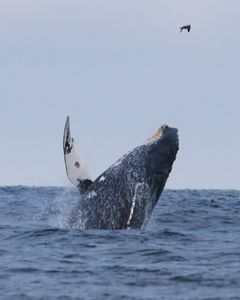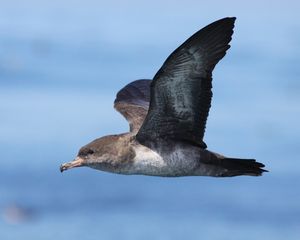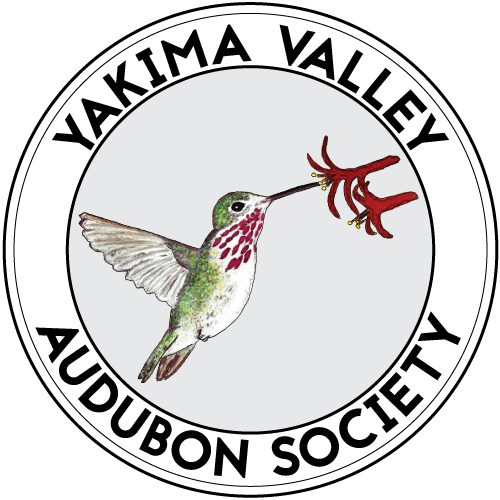Westport Seabirds - Five decades of watching seabirds and marine mammals off Washington’s Coast with Bill Tweit - February 2022 - YVAS Program
General ·Westport Seabirds: Five decades of watching seabirds and marine mammals off Washington’s Coast with Bill TweitThe February program introduces you to the remarkable world of pelagic birds just a few tens of miles off the Washington coast. This is a world the Yakima Valley Audubon invites you to experience firsthand on a 3-day fieldtrip, including a boat trip, this upcoming August 26-28. A pelagic trip off the coast of Washington offers birders the opportunity to see a number of bird species never or very rarely met with from shore. These birds are wedded to the pelagic zone which includes both the Continental Shelf and the deeper waters that lie beyond the shelf edge, about 30 miles offshore. The shelf edge is an abrupt break where the seafloor plunges to great depths of several thousand feet. The pelagic zone is home especially for “tubenoses,” birds that have external nostrils shaped like tubes on their upper bill. These are thought to aid in their ability to smell, enabling them to locate food which is patchily distributed in their ocean environment. Pelagic birds present off our coast include several species of magnificent albatrosses, a half dozen of fast-flying shearwaters, the Northern Fulmar, several swallow-like storm-petrels, the thuggish South Polar Skua, three species of piratical jaegers, the Arctic Tern and Sabine’s Gull. Of course, marine mammals are present in pelagic waters such as a variety of whale species (Humpbacks are often noted), along with various types of dolphins and porpoises, and fur seals. Adding interest to the pelagic environment for observers is the huge, flat-shaped Sunfish, Blue Sharks, and rarely, the giant Leatherback Turtle. Bill Tweit has been going on pelagic trips since 1970; his first trip off Westport was in 1974; and he began to lead Westport pelagic trips in 1977. While guiding pelagic trips is one of his favorite birding activities, he also enjoys birding throughout the Northwest and the world, and helping document Washington’s bird life for scientific and conservation purposes. Along with Terry Wahl and Steve Mlodinow, he wrote the Birds of Washington: Status and Distribution, published in 2005. He has also been a Regional Editor of North American Birds for several decades, and now is a reviewer for eBird in Washington. He has served several terms on the Washington Bird Records Committee. He works for the Washington Department of Fish and Wildlife as a Special Assistant, responsible for representing Washington in management of the federal fisheries in the Gulf of Alaska and the Bering Sea, and until recently was also engaged in protecting and managing Columbia River fish populations and fisheries. He and his wife, Lucy Winter, are travelers and also active supporters of the Olympia Symphony Orchestra.
Posted by Yakima Valley Audubon Society on Wednesday, March 2, 2022

The February program introduces you to the remarkable world of pelagic birds just a few tens of miles off the Washington coast. This is a world the Yakima Valley Audubon invites you to experience firsthand on a 3-day fieldtrip, including a boat trip, this upcoming August 26-28.

A pelagic trip off the coast of Washington offers birders the opportunity to see a number of bird species never or very rarely met with from shore. These birds are wedded to the pelagic zone which includes both the Continental Shelf and the deeper waters that lie beyond the shelf edge, about 30 miles offshore. The shelf edge is an abrupt break where the seafloor plunges to great depths of several thousand feet. The pelagic zone is home especially for “tubenoses,” birds that have external nostrils shaped like tubes on their upper bill. These are thought to aid in their ability to smell, enabling them to locate food which is patchily distributed in their ocean environment. Pelagic birds present off our coast include several species of magnificent albatrosses, a half dozen of fast-flying shearwaters, the Northern Fulmar, several swallow-like storm-petrels, the thuggish South Polar Skua, three species of piratical jaegers, the Arctic Tern and Sabine’s Gull. Of course, marine mammals are present in pelagic waters such as a variety of whale species (Humpbacks are often noted), along with various types of dolphins and porpoises, and fur seals. Adding interest to the pelagic environment for observers is the huge, flat-shaped Sunfish, Blue Sharks, and rarely, the giant Leatherback Turtle.

Bill Tweit has been going on pelagic trips since 1970; his first trip off Westport was in 1974; and he began to lead Westport pelagic trips in 1977. While guiding pelagic trips is one of his favorite birding activities, he also enjoys birding throughout the Northwest and the world, and helping document Washington’s bird life for scientific and conservation purposes. Along with Terry Wahl and Steve Mlodinow, he wrote the Birds of Washington: Status and Distribution, published in 2005. He has also been a Regional Editor of North American Birds for several decades, and now is a reviewer for eBird in Washington. He has served several terms on the Washington Bird Records Committee. He works for the Washington Department of Fish and Wildlife as a Special Assistant, responsible for representing Washington in management of the federal fisheries in the Gulf of Alaska and the Bering Sea, and until recently was also engaged in protecting and managing Columbia River fish populations and fisheries. He and his wife, Lucy Winter, are travelers and also active supporters of the Olympia Symphony Orchestra.
